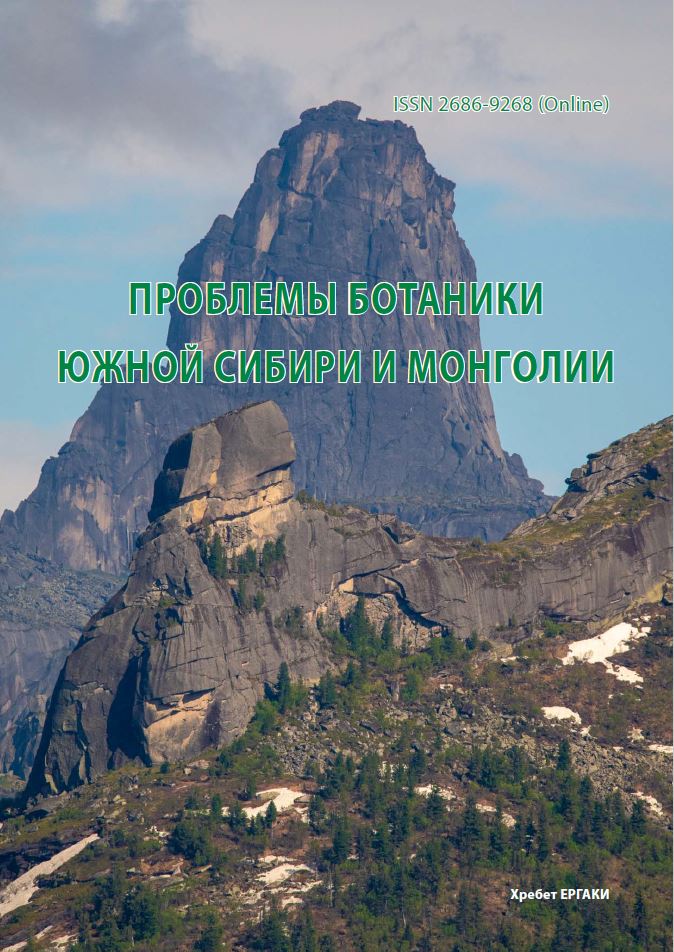Morphological and phylogenetic analysis of Erythronium (Liliaceae) species in Southern Siberia
УДК 582.572+575.86(571.1)
Abstract
This study presents morphological and phylogenetic analyses of 3 species of Erythronium growing in the mountains of Southern Siberia. Species are Erythronium sibiricum (Fisch. et Mey) Krylov, E. sajanense Stepanov et Stassova, E. sulevii (Ruksans) Stepanov. According to the morphological parameters of the species, E. sajanense shows the clearest isolation, characterized by small peduncles; awl-shaped staminate filaments, sharply narrowing at the base; a more compact stigma of the pistil; the color of the perianth petals. According to the principal component analysis, E. sajanense separates from the other two species. Phylogenetic analysis was based on sequencing chloroplast genes matK, rbcL and the nuclear marker ITS (ITS1-5.8S rDNA-ITS2). The phylogenetic trees show a clear division of the species of Erythronium into the Eurasian and East-North American groups. The maximum number of nucleotide substitutions was noted for E. sajanense, whereas E. sibiricum and E. sulevii show greater genetic similarity. The most informative markers for the identification of Erythronium species are ITS regions characterized by a high level of variability between individual species.
Downloads
Metrics
References
Степанов Н. В., Стасова В. В. О новом таксоне рода кандык (Erythronium - Liliaceae) из Западного Саяна // Вестник КрасГАУ, 2011. - № 8. - С. 58-63.
Allen G. A., Soltis D. E., Soltis P. S. Phylogeny and biogeography of Erythronium (Liliaceae) inferred from chloroplast matK and nuclear rDNA ITS sequences // Systematic Botany, 2003. - Vol. 28. - Р. 512-523.
Bartha L., Stepanov N. V., Ruksans J., Banciu H., Keresztes L. Non-monophyly of Siberian Erythronium (Liliaceae) leads to the recognition of the formerly neglected Erythronium sajanense // Journal of plant research, 2015. - Is. 128. -Р. 721-729.
Clennett C. The Genus Erythronium. - Royal Botanic Gardens: Kew Publishing, 2014. - 250 р.
Doyle J. J., Doyle J. L. A Rapid DNA Isolation Procedure for Small Quantities of Fresh Leaf Tissue // Phytochemical Bulletin, 1987. - Vol. 19. - Р. 11-15.
Kassambara F., Mundt F. Factoextra: Extract and Visualize the Results of Multivariate Data Analyses. R package version 1.0.7., 2020.
Ruksans J. Buried Treasures: Finding and Growing the World’s Choicest Bulbs. - Timber Press, 2007. - 524 p.
Takahashi М. Pollen morphology in the genus Erythronium (Liliaceae) and its systematic implications // American Journal of Botany, 1987. - № 74. - Р. 1254-1262.
Tamura K., Nei M. Estimation of the number of nucleotide substitutions in the control region of mitochondrial DNA in humans and chimpanzees // Molecular Biology and Evolution, 1993. - Vol. 10, iss. 3. - Р. 512-526.
Tamura K., Stecher G., Kumar S. MEGA 11: Molecular Evolutionary Genetics Analysis Version 11 // Molecular Biology and Evolution, 2021. - Vol. 38, iss. 7. - Р. 3022-3027.
Tukey J. W. Comparing individual means in the analysis of variance // Biometrics, 1949. - Vol. 5, iss. 2. - Р. 99-114.
WFO: World Flora Online. URL:http://www.worldfloraonline.org. (Accessed 14 May 2023).



